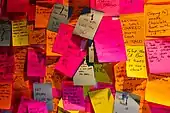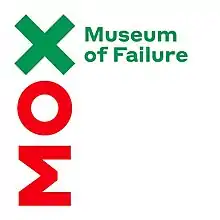Museum of Failure
The Museum of Failure[1] is a museum that features a collection of failed products and services. The touring exhibition provides visitors with a learning experience about the critical role of failure in innovation and encourages organizations to become better at learning from failure. Samuel West's 2016 visit to the Museum of Broken Relationships in Zagreb, Croatia, inspired the concept of the museum.[2] Museum founder and curator Samuel West reportedly registered a domain name for the museum and later realized he had misspelled the word museum.[3] The Swedish Innovation Authority (Vinnova) partially funded the museum.[4] The exhibition opened on June 7, 2017, in Helsingborg, Sweden.[3] The exhibit reopened at Dunkers Kulturhus on June 2, 2018, before closing in January 2019. A temporary exhibit opened in Los Angeles, California, in December 2017.[5] The Los Angeles museum was on Hollywood Boulevard in the Hollywood & Highland Center.[6] The exhibit opened in January - March 2019 at Shanghai, No.1 Center (上海第一百货). [7] And in December 2019 a smaller version opened in Paris, France at the Cité des Sciences et de l'Industrie along with other interesting failure-related exhibitions for the "Festival of Failures" (Les Foirés festival des flops, des bides, des ratés et des inutiles).[8]


According to West, the goal of the museum is to help people recognize "we need to accept failure if we want progress", and to emphasize to companies to learn more from their failures without resorting to "cliches".[9]
The growing collection consists of over 150[1] failed products and services worldwide. Every item provides insight into the risky business of innovation. Some examples of the items on display: Apple Newton, Bic for Her, Google Glass, N-Gage, lobotomy instruments, Harley-Davidson Cologne, Kodak DC-40, Sony Betamax, Lego Fiber Optics, the My Friend Cayla talking doll,[10] and Paolo Macchiarini's infamous plastic trachea.
In 2017, one of the products on display at the museum, the Colgate lasagna, went viral on social media. Although initially believed to be genuine, some sources reported that the museum had fabricated the products existence.[11] In May 2020, the museum made most of the collection of artifacts available for viewing on its website. As Covid-19 virus restrictions closed most museums around the globe, many have offered free virtual tours.[12]
The museum has received international attention for its unusual collection.[13][14][15][16]
References
- "About". Museumoffailure.se. Archived from the original on 2017-05-03. Retrieved 2017-05-03.
- "Största flopparna: Segway, cashkort och plastcykel | SvD". Svd.se. Archived from the original on 2017-04-07. Retrieved 2017-05-03.
- "Sweden's Museum of Failure highlights products that flopped". Washington Post. June 12, 2017. Archived from the original on June 12, 2017. Retrieved June 13, 2017.
- "Museum of Failure". Vinnova.se. 2017-02-27. Archived from the original on 2017-03-30. Retrieved 2017-05-03.
- http://failuremuseum.com/event/ad-architecture-design-museum/A pop-up version of the museum is on an international tour.
- "The Museum of Failure Has a New Home at Hollywood & Highland". 2018-03-08. Archived from the original on 2018-03-13. Retrieved 2018-03-13.
- Group, SEEC Media. "5 excellent fails at the newly opened Museum of Failure". www.timeoutshanghai.com. Archived from the original on 2019-09-13. Retrieved 2020-05-06.
- "Des flops au top ! - Les foirés - Événements passés - Ressources - Cité des sciences et de l'industrie". www.cite-sciences.fr (in French). Archived from the original on 2020-05-31. Retrieved 2020-05-06.
- Drollette Jr., Dan (January 16, 2023). "Interview with Samuel West, founder of the Museum of Failure". thebulletin.org. Bulletin of the Atomic Scientists. Archived from the original on January 16, 2023. Retrieved January 16, 2023.
No, not at all. The whole aim of the museum is to help people recognize that we need to accept failure if we want progress. And by that I mean any kind of progress, not just consumer products and new devices. The main point is that we have to accept failure, because it usually takes several iterations before we get things right—most experiments fail. And then the second point—which I try to make money off of, with varying degrees of success—is to emphasize that companies in particular have to be better at learning from their failures. A corollary is that it is not cool just to "fail fast"—as they like to say in Silicon Valley. Or to "move fast and break things," or any of those clichés. Yes, it's okay to fail, but you have to learn something from the experience. Those are the goals of the museum, anyway.
- Lidz, Franz. "The Museum of Failure Showcases the Beauty of the Epic Fail". Smithsonian Magazine. Archived from the original on 27 March 2020. Retrieved 27 March 2020.
- Harris, Harry. "What a viral fake lasagna taught me about failure". Prospect Magazine. Archived from the original on 2022-09-27. Retrieved 2023-08-11.
- Farago, Jason (2020-04-23). "Now Virtual and in Video, Museum Websites Shake Off the Dust". The New York Times. ISSN 0362-4331. Archived from the original on 2020-05-07. Retrieved 2020-05-06.
- "The Museum of Failure in Sweden argues that real innovation requires failure — Quartz". Qz.com. 2017-04-13. Archived from the original on 2017-04-25. Retrieved 2017-05-03.
- Vonberg, Judith (2017-04-06). "Museum showcases innovation failures". Edition.cnn.com. CNN. Archived from the original on 2017-04-20. Retrieved 2017-05-03.
- "The Museum of Failure showcases — and celebrates — really terrible ideas - Home | As It Happens | CBC Radio". Cbc.ca. 2017-04-06. Archived from the original on 2017-04-30. Retrieved 2017-05-03.
- "Sweden to open 'Museum of Failure' showcasing flop products". Thelocal.se. 2017-04-05. Archived from the original on 2017-05-17. Retrieved 2017-05-03.
Further reading
- Danner, J., & Coopersmith, M. (2015). The Other "F" Word: How Smart Leaders, Teams, and Entrepreneurs Put Failure to Work. John Wiley & Sons.
- Cannon, M. D., & Edmondson, A. C. (2005). Failing to learn and learning to fail (intelligently): How great organizations put failure to work to innovate and improve. Long Range Planning, 38(3), 299–319.
- Khanna, R., Guler, I., & Nerkar, A. (2016). Fail often, fail big, and fail fast? Learning from small failures and R&D performance in the pharmaceutical industry. Academy of Management Journal, 59(2), 436–459.
- What Google Learned From Its Quest to Build the Perfect Team, New York Times, 28 February 2016.
- Frazier, M. L., Fainshmidt, S., Klinger, R. L., Pezeshkan, A., & Vracheva, V. (2017). Psychological safety: A meta‐analytic review and extension. Personnel Psychology, 70(1), 113–165.
- Agarwal, P., & Farndale, E. (2017). High‐performance work systems and creativity implementation: the role of psychological capital and psychological safety. Human Resource Management Journal.
- West, S., & Shiu, E. C. C. (2014). Play as a facilitator of organizational creativity. Creativity research: An inter-disciplinary and multi-disciplinary research handbook (2014), 191–206.